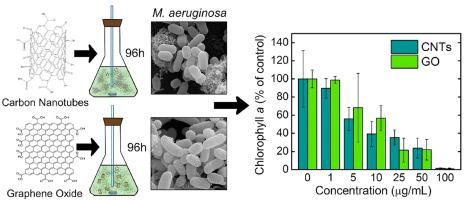Chemosphere ( IF 8.1 ) Pub Date : 2020-11-29 , DOI: 10.1016/j.chemosphere.2020.129137 Edgardo Cruces , Ana C. Barrios , Yaritza P. Cahue , Brielle Januszewski , Leanne M. Gilbertson , François Perreault

|
In photosynthetic microorganisms, the toxicity of carbon nanomaterials (CNMs) is typically characterized by a decrease in growth, viability, photosynthesis, as well as the induction of oxidative stress. However, it is currently unclear how the shape of the carbon structure in CNMs, such as in the 1-dimensional carbon nanotubes (CNTs) compared to the two-dimensional graphene oxide (GO), affects the way they interact with cells. In this study, the effects of GO and oxidized multi-walled CNTs were compared in the cyanobacterium Microcystis aeruginosa to determine the similarities or differences in how the two CNMs interact with and induce toxicity to cyanobacteria. Using change in Chlorophyll a concentrations, the effective concentrations inducing 50% inhibition (EC50) at 96h are found to be 11.1 μg/mL and 7.38 μg/mL for GO and CNTs, respectively. The EC50 of the two CNMs were not found to be statistically different. Changes in fluorescein diacetate and 2',7'-dichlorodihydrofluorescein diacetate fluorescence, measured at the EC50 concentrations, suggests a decrease in esterase enzyme activity but no oxidative stress. Scanning and transmission electron microscopy imaging did not show extensive membrane damage in cells exposed to GO or CNTs. Altogether, the decrease in metabolic activity and photosynthetic activity without oxidative stress or membrane damage support the hypothesis that both GO and CNTs induced indirect toxicity through physical mechanisms associated with light shading and cell aggregation. This indirect toxicity explains why the intrinsic differences in shape, size, and surface properties between CNTs and GO did not result in differences in how they induce toxicity to cyanobacteria.
中文翻译:

铜绿微囊藻中氧化石墨烯与氧化的多壁碳纳米管的相似毒性机理
在光合作用微生物中,碳纳米材料(CNMs)的毒性通常以生长,生存力,光合作用的降低以及氧化应激的诱导为特征。但是,目前尚不清楚与二维石墨烯氧化物(GO)相比,CNM中碳结构的形状(例如,一维碳纳米管(CNT)中的碳结构)如何影响它们与细胞相互作用的方式。在这项研究中,GO和氧化的多壁CNT在铜绿微囊藻中的作用进行了比较,以确定两个CNM与蓝藻相互作用和诱导蓝藻毒性的相似性或差异。利用叶绿素a浓度的变化,有效浓度可诱导50%的抑制作用(EC 50)在96h时发现GO和CNT的浓度分别为11.1μg/ mL和7.38μg/ mL。没有发现两个CNM的EC 50有统计学差异。在EC 50下测得的二乙酸荧光素和2',7'-二氯二氢荧光素二乙酸酯荧光的变化浓度升高表明酯酶活性降低,但没有氧化应激。扫描和透射电子显微镜成像在暴露于GO或CNT的细胞中未显示出广泛的膜损伤。总而言之,在没有氧化应激或膜损伤的情况下,代谢活性和光合活性的降低支持了以下假设:GO和CNT都通过与光影和细胞聚集相关的物理机制诱导了间接毒性。这种间接毒性解释了为什么CNT和GO之间形状,大小和表面性质的内在差异不会导致它们对蓝细菌的毒性诱导方式上的差异。











































 京公网安备 11010802027423号
京公网安备 11010802027423号